Agricultural Pheromones Market Size and Forecast 2025 to 2034
The global agricultural pheromones market size was estimated at USD 5.02 billion in 2024 and is predicted to increase from USD 5.90 billion in 2025 to approximately USD 25.40 billion by 2034, expanding at a CAGR of 17.60% from 2025 to 2034. The growth of the market is driven by the rising demand for sustainable, targeted pest control solutions. Moreover, stringent regulations on chemical pesticide use and the widespread adoption of integrated pest management practices contribute to market growth.
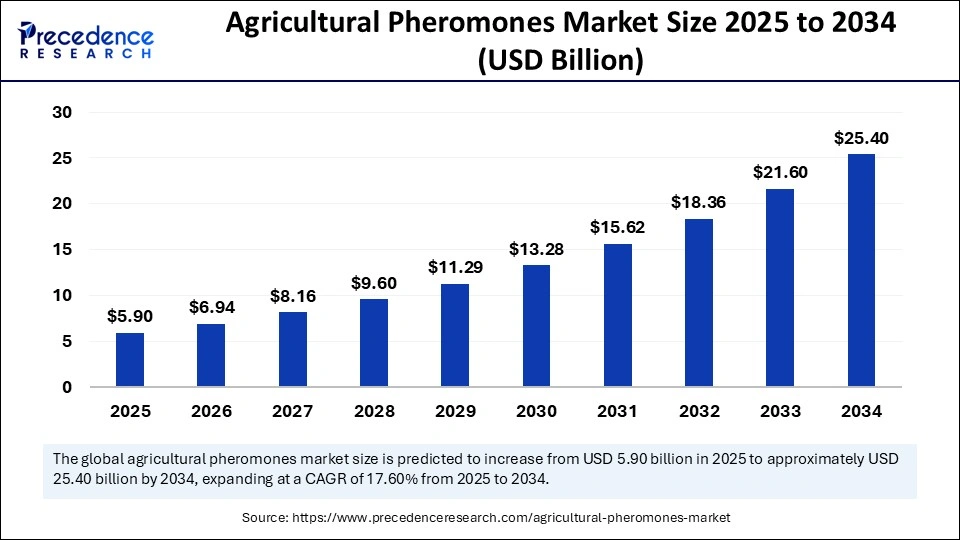
Agricultural Pheromones Market Key Takeaways
- North America dominated the market with the largest share of 34% in 2024.
- Asia Pacific is expected to expand at the fastest CAGR during the forecast period.
- By type, the sex pheromones segment held a significant market share of 89% in 2024.
- By type, the aggregation pheromones segment is expected to grow at the fastest rate in the coming years.
- By function, the mating disruption segment dominated the agricultural pheromones market with the largest share in 2024.
- By function, the mass trapping segment is projected to grow at a significant rate during the projection period.
- By application, the dispensers segment led the market in 2024.
- By application, the traps segment is expected to grow at the fastest rate in the market during the forecast period.
- By crop type, the orchard crops segment dominated the market with the largest share in 2024.
- By crop type, the field crops segment is expected to grow at a notable rate in the upcoming period.
How is AI Optimizing Pheromone Application in Agriculture?
By facilitating more accurate and focused pest control, artificial intelligence is greatly optimized pheromone applications in agriculture. It is now possible to program pheromone dispensers to release precise amounts of pheromone at the appropriate time and place by using AI-powered systems. Real-time adjustments are possible thanks to machine learning algorithms that evaluate environmental data like crop conditions, pest activity, and weather. As a result, farming methods become more sustainable by lowering the need for broad-spectrum pesticides, cutting waste, and improving pheromone application efficiency.
Pheromone applications for various crop areas can be customized based on pest pressure and growth stages thanks to AI integration, which enables precision farming techniques. Farmers can monitor pheromone efficacy and pest populations using internet of things IoT devices and AI analytics. AI leads to automation and data-driven decision making a more effective pest management system that is economical and ecologically friendly. As a result, AI is significantly contributing to the agricultural pheromones market, offering specialized solutions to address pest infestations with little harm to the environment.
U.S. Agricultural Pheromones Market Size and Growth 2025 to 2034
The U.S. agricultural pheromones market size was exhibited at USD 1.28 billion in 2024 and is projected to be worth around USD 42.83 billion by 2034, growing at a CAGR of 6.62% from 2025 to 2034.
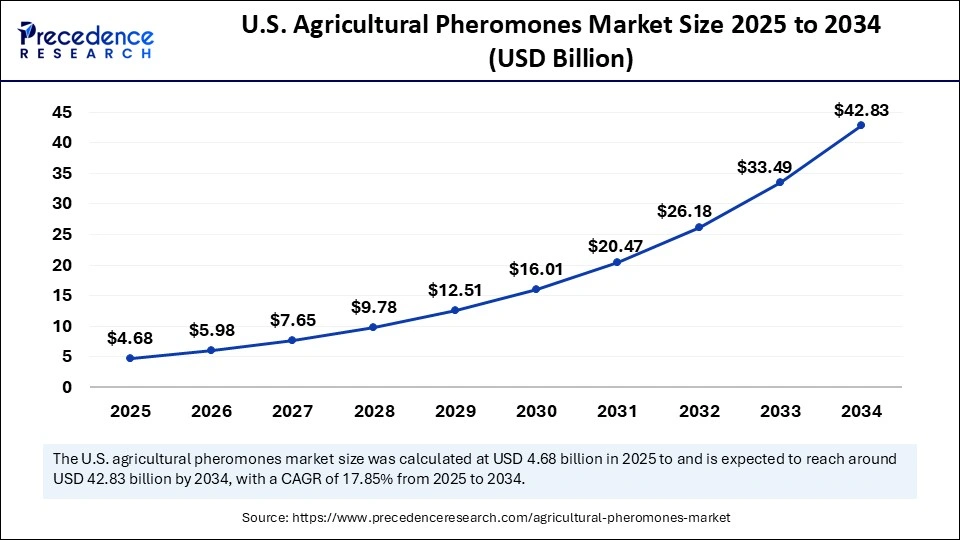
North America dominated the agricultural pheromones market with the largest share in 2024. This is mainly due to the heightened awareness among farmers about the advantages of pheromone-based solutions. There are favorable policies that support sustainable farming practices. Increased adoption of cutting-edge pest management techniques further bolstered the market in the region. Nations like the U.S. and Canada have long-standing integrated pest management (IPM) programs, creating opportunities for agricultural pheromones. The growing focus on lowering the use of chemical pesticides further supports regional market growth in the long run. The growth of the market in the region is further attributed to the presence of leading pheromone producers and ongoing investments in agricultural R&D.
Asia Pacific is expected to witness the fastest growth in the upcoming period. The adoption of pheromone-based solutions is rising in the region. There is a strong emphasis on sustainable farming practices, which is one of the key factors driving regional market growth. Farmers in the region are rapidly shifting toward environmentally friendly pest control methods. The rising awareness among farmers about the importance of cutting back on chemical inputs further supports market growth. Growing organic and IPM practices, as well as supportive government initiatives, are solidifying the region's position in the market. In addition, the region has an extensive agricultural base, which positively impacts the market.
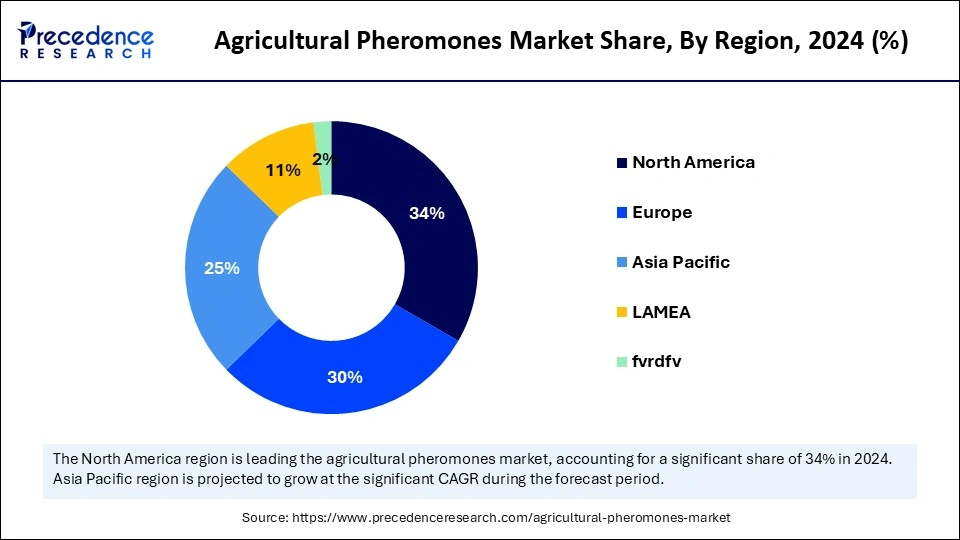
Europe is observed to grow at a considerable growth rate in the upcoming period. The growth of the agricultural pheromones market in Europe is driven by strict environmental laws and a strong emphasis on environmentally friendly farming practices. Farmers in the area are progressively implementing pheromone-based products to satisfy consumer demand for pesticide-free produce and comply with green agricultural standards. The broad acceptance of IPM techniques and stringent regulations to cut back on the use of chemical pesticides further support regional market growth. The rising adoption of sustainable farming practices also contributes to market growth.
Market Overview
The agricultural pheromones market is witnessing rapid growth due to the rising shift toward sustainable farming practices and the increasing focus on eco-friendly pest management solutions. Because pheromone-based products provide species-specific pest control without endangering beneficial insects to the environment, farmers and the agricultural sector are using them more and more. The need for biological alternatives like pheromones is rising due to the growing concerns about the detrimental effects of chemical pesticides as well as the introduction of strict government regulations. Pheromone-based pest control techniques have also become increasingly popular due to the rise in organic farming and consumer demand for food items free of residue.
Agricultural Pheromones Market Growth Factors
- Shift Toward Sustainable Agriculture: Farmers and agribusinesses prefer biological solutions to minimize soil and water contamination.
- Pheromones offer species-specific control without harming beneficial insects.
- Increasing Demand for Organic Food: Organic farming demands pest control methods free from synthetic chemicals. Pheromones help farmers meet organic certification standards effectively.
- Technological Advancements: Enhanced microencapsulation and controlled release technologies improve pheromone efficiency.
- Affordable production techniques are making pheromones accessible to small and medium farmers.
- Growing Pest Resistance to Conventional Pesticides: Traditional chemical pesticides are becoming less effective against resistant pests.
- Pheromones disrupt mating cycles, offering a unique resistance-free control method.
- Awareness about Environmental Impact: Farmers and companies are prioritizing biodiversity and ecological balance. Pheromones are seen as eco-positive, maintaining pollinator health and reducing runoff pollution.
Market Scope
| Report Coverage | Details |
| Market Size by 2034 | USD 25.40 Billion |
| Market Size in 2025 | USD 5.90 Billion |
| Market Size in 2024 | USD 5.02 Billion |
| Market Growth Rate from 2025 to 2034 | CAGR of 17.60% |
| Dominated Region | North America |
| Fastest Growing Market | Asia Pacific |
| Base Year | 2024 |
| Forecast Period | 2025 to 2034 |
| Segments Covered | Type, Function, Application, Crop Type, and Region |
| Regions Covered | North America, Europe, Asia-Pacific, Latin America and Middle East & Africa |
Market Dynamics
Drivers
Technological Advancements
Technological advancements significantly drive the growth of the agricultural pheromones market. New technologies are becoming more economical and efficient for the development of pheromone production. The usability and durability of pheromone products are being improved by technologies such as automated pheromone dispensers, slow-release formulations, and micro capsulations. Technological advancements may result in pheromone systems that are easier to use and more reasonably priced, which would encourage adoption at all farming scales. This has greatly increased their use in a variety of kinds and agricultural systems. Small and medium-sized farmers can now use pheromones due to decreased production costs. It is anticipated that pheromone adoption will increase even further as technology develops.
- In February 2024, Provivi Inc. launched its next-generation microencapsulated pheromone formulations, enhancing pheromone longevity in the field and making pest control more efficient and predictable for farmers globally.
Pest Resistance to Chemical Pesticides
Due to the overuse of chemical pesticides, resistant pest populations have emerged, making many conventional control techniques useless. Without using hazardous chemicals, pheromones provide a novel way to interfere with pest mating cycles. Pest resistance is less likely to develop because it focuses on behavioral mechanisms rather than physical survival. For this reason, pheromones are essential components in the long-term pest component solution. Their adoption is being driven more and more by the need for resistance-free solutions. Furthermore, by diverting pests from crops, pheromone-based tactics lower pest damage and the amount of pesticide residues in food items. Using pheromones or other alternative solutions is becoming more and more important in maintaining agricultural sustainability and productivity as chemical pesticide resistance keeps growing.
- Recently, Pherobank announced the development of customized pheromone blends specifically designed to control pest species that had developed resistance to conventional chemical treatments.
Restraints
High Initial Cost of Pheromone Products
A primary obstacle to the extensive use of agricultural pheromones is their comparatively high initial cost when compared to conventional chemical pesticides, which hampers the growth of the agricultural pheromones market. The upfront investment may be too costly for many small to medium-sized farmers even though the long-term advantages, like less environmental harm and pesticide use, can offset these costs. Pheromone-based pest control techniques may be slower to take off as a result of this cost barrier, particularly in developing nations where economic conditions are more difficult. Farmers may choose less expensive but possibly more hazardous chemicals pesticides in areas where price sensitivity is high which would impede the market's expansion.
- Additionally, the need for specialized equipment and technology to apply pheromones effectively further increases the total cost. The lack of local production and reliance on imports in certain markets also add to the expense, limiting accessibility for farmers in lower-income regions.
Limited Knowledge and Awareness Among Farmers
Many farmers are still unfamiliar with the idea of using pheromones for pest control, especially in areas where chemical pesticides have been the mainstay of pest management for many years. Adoption of pheromones may be restricted by ignorance and a lack of knowledge about their proper use. To overcome this obstacle, educational programs are essential but require time and money.
The scientific underpinnings of pheromone-based pest control, as well as the appropriate timing and application techniques, are also difficult for many farmers to comprehend. Another factor preventing pheromone-based pest management from being widely adopted is the learning curve, which arises because it necessitates more accurate and knowledgeable application than traditional chemicals. It is more likely that pheromone products will be applied incorrectly without the right guidance and assistance which could result in decreased effectiveness and unfavorable opinions about them.
Opportunity
Emerging Markets
Emerging markets such as Asia Pacific, Africa, and Latin America present immense opportunities in the agricultural pheromones market. Many emerging markets have limited access to traditional pesticides due to costs and regulatory restrictions, making pheromones a viable alternative. Chemical pesticides are still frequently used in these areas. As farmers in these areas are looking for safer alternatives to dangerous chemicals, the demand for pheromones is predicted to increase. NGOs and international organizations are promoting sustainable farming methods in developing nations, increasing the potential for pheromone-based solutions. Efficient and sustainable pest control techniques will also be more important as these areas increase their agricultural output to satisfy the rising demand for food worldwide, and because of this, there is an unexplored market for pheromone products, especially in high-value crops like spices, fruits, and vegetables.
Type
The sex pheromones segment held a significant share of the agricultural pheromones market in 2024. Sex pheromones are widely used in pest management, especially for targeted and eco-friendly insect population monitoring and control. Because sex pheromones are so species-specific, they have less of an effect on organisms that are not the intended target and encourage environmentally friendly farming methods. In the production of fruits, vegetables, and field crops, they are extensively used to assist farmers in drastically lowering their use of chemical pesticides. Furthermore, the need for sex pheromones in agriculture is further bolstered by growing government support and regulatory initiatives promoting bio-based crop protection techniques. Farmers all over the world continue to embrace them due to their key role in integrated pest management (IPM) techniques.
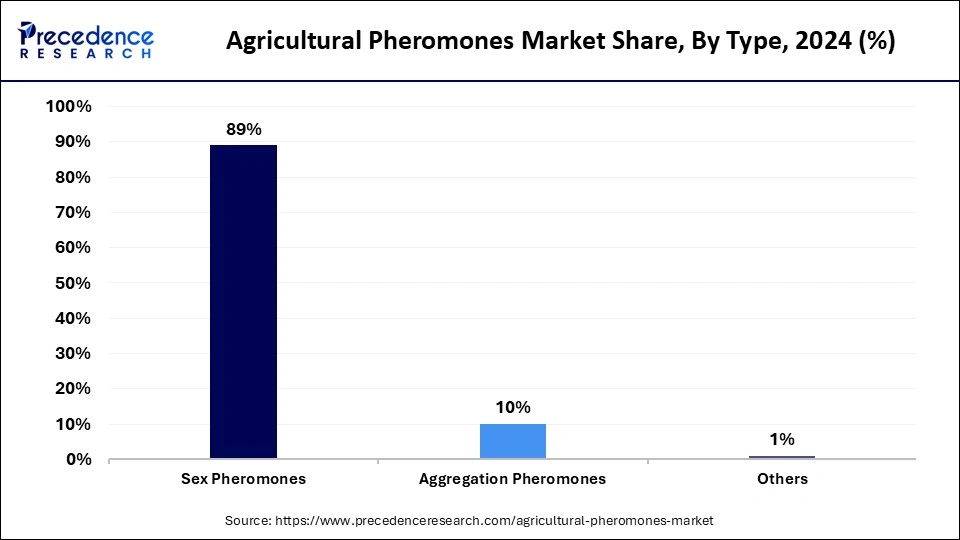
The aggregation pheromones segment is expected to grow at the fastest rate in the coming years. Farmers are looking for more sustainable and efficient alternatives to traditional chemical pesticides, which is boosting the use of aggregation pheromones for mass trapping and pest aggregation techniques. Larger-scale pest population management is made possible by aggregation pheromones that draw male and female insects. This ability is especially useful for managing large infestations and invasive species that endanger crop yields. Additionally, technological developments and innovations in pheromone formulations and delivery systems have increased the use of aggregation pheromones. Additionally, the demand for aggregation pheromones is anticipated to increase in the upcoming years due to farmers growing awareness of environmentally friendly pest control options and the increased focus on organic farming methods.
Function
The mating disruption segment held the largest share of the agricultural pheromones market in 2024. The efficiency of mating disruption techniques in managing pest populations without the use of chemical pesticides is a major factor in their increasing use. This method promotes sustainable farming methods, improves yield quality, and drastically lowers crop damage. The demand for mating disruption is also driven by growing awareness of its long-term advantages, including reducing pesticide resistance and protecting beneficial insect species. The segment's growth is further attributed to favorable government regulations that support environmentally friendly pest control methods.
The mass trapping segment is projected to grow at a significant rate during the projection period. By using pheromone-baited traps to catch a lot of pests, mass trapping lowers their population below harmful thresholds. Mass trapping solutions are being adopted rapidly due to the increased emphasis on organic farming and integrated pest management (IPM) techniques. Mass trapping is becoming more and more recognized by farmers as an economical and environmentally friendly substitute for chemical control techniques. Mass trapping is becoming increasingly more effective and widely available thanks to developments in monitoring technologies, pheromone formulations, and trap designs. In addition, the growing demand for crops free of pesticides and the growing worries about pesticide residues in food products are anticipated to propel the segment's growth in the upcoming years.
Application
The dispensers segment dominated the agricultural pheromones market in 2024. To provide consistent pest control through mating disruption, pheromones are routinely released over a long period using dispensers. They are the go-to option for farmers looking for dependable pest management solutions because of their effectiveness, durability, and simplicity of application. Large-scale farming operations where consistent pheromone distribution is essential for success benefit greatly from dispensers. Dispenser technology developments like microencapsulation and controlled-release systems are also improving their functionality and accelerating adoption. In the upcoming years, the dispenser segment is anticipated to continue to hold a strong position due to supportive government regulations that encourage sustainable agriculture and raise awareness of the negative effects of synthetic pesticides.
The traps segment is expected to grow at the fastest rate in the market during the forecast period. The main applications of pheromone traps are mass trapping and pest monitoring, providing farmers with an economical and environmentally responsible approach to pest management. The rapid adoption of traps across various crop types is driven by the growing consumer demand for agricultural products free of residue and the growing popularity of integrated pest management (IPM) techniques. Technological developments like smart traps that are connected to remote monitoring systems are making pheromone-based traps more appealing. Furthermore, traps are very appealing, especially for small and medium-sized farmers, due to their lower initial investment requirements when compared to alternative solutions. The rising global awareness of sustainable farming practices is likely to support segmental growth.
Crop Type
The orchard crops segment led the agricultural pheromones market with the largest share in 2024. Pheromone applications have shown great efficacy in orchard crops like apples, pears, peaches, and citrus fruits where pest pressure can be high and targeted pest management is essential. To maintain high-quality yields while reducing the use of chemical pesticides, farmers cultivating orchard crops frequently employ pheromone-based solutions, particularly mating disruption and mass trapping techniques. Investing in pheromone technologies is further justified by the lengthy growing seasons and high economic value of orchard produce. More orchards are using environmentally friendly pest control techniques as a result of stringent laws governing pesticide residues in fruit exports. The increased concerns about sustainability and the desire for organic fruits further bolstered the segment's growth.
The field crops segment is expected to grow at a notable rate in the upcoming period. The use of pheromone-based pest management techniques in field crop farming is being propelled by the rise in pest infestation problems in crops like corn, cotton, and soybean. As chemical pesticide resistance becomes a greater concern, farmers are realizing the advantages of employing pheromones for extensive economic pest control. Furthermore, pheromone uptake in field crops is aided by government initiatives supporting sustainable agriculture and expanding integrated pest management (IPM) practices. Effective pheromone application in open-field environments is also becoming simpler thanks to technological developments like better pheromone dispensers and more crop-specific formulations. The rising emphasis on minimizing environmental impact further boosts the demand for agricultural pheromones.
Agricultural Pheromones Market Companies
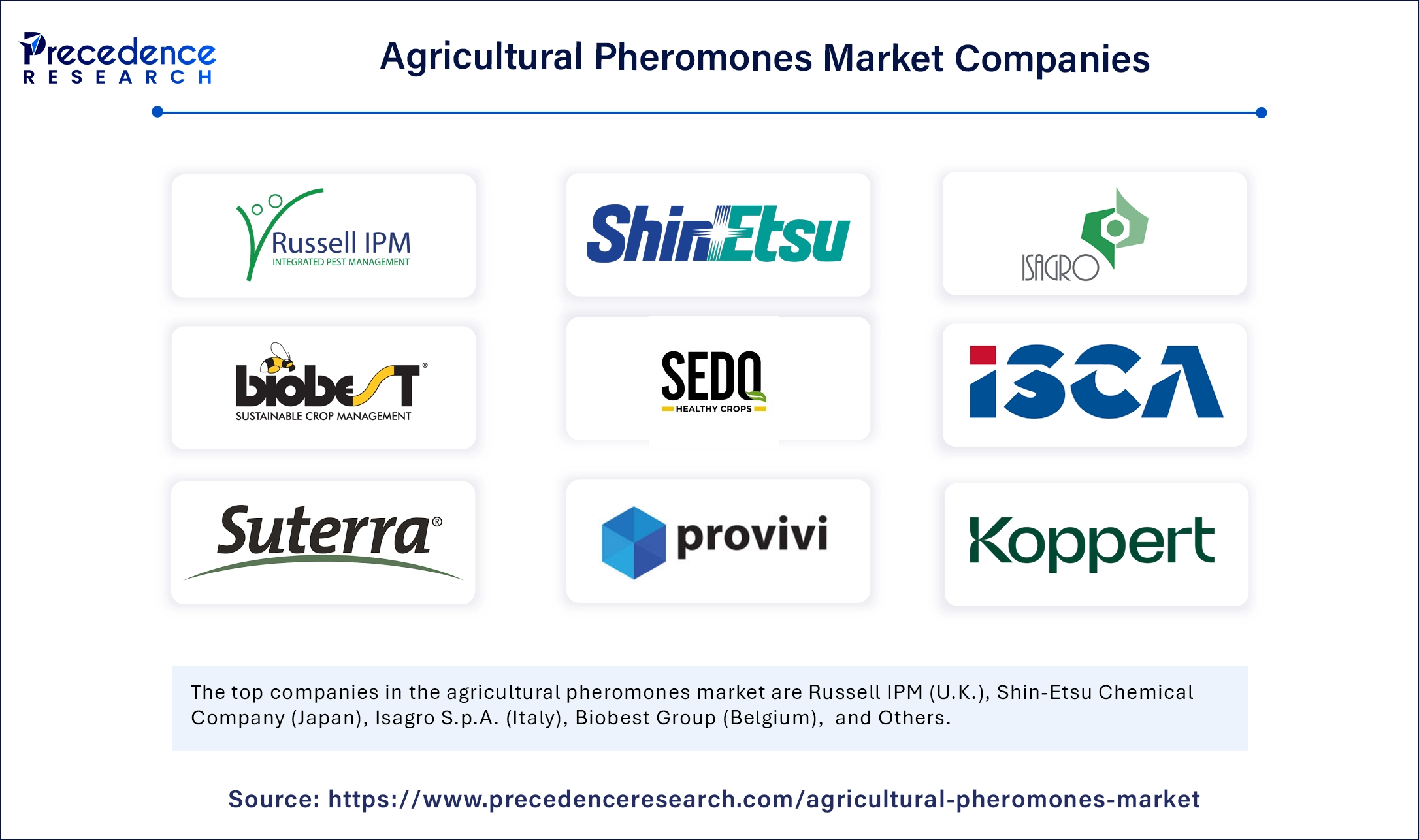
- Russell IPM (U.K.)
- Shin-Etsu Chemical Company (Japan)
- Isagro S.p.A. (Italy)
- Biobest Group (Belgium)
- SEDQ Healthy Crops SL (Spain)
- ISCA Global (U.S.)
- Suterra LLC (U.S.)
- Provivi, Inc. (U.S.)
- Koppert Biological Systems (Netherlands)
- Pacific Biocontrol Corporation (U.S.)
Latest Announcements by Industry Leaders
- In April 2024, ISCA Technologies announced the launch of its Eco Pheromone system for pest control in citrus farming. The product is designed to disrupt the mating cycle of citrus pests such as Mediterranean fruit flies. Dr. James Lee, the chief executive officer of ISCA technologies, stated, “With Eco Pheromone we aim to provide farmers with a sustainable solution that not only helps protect their crops but also ensures minimal environmental impact, which is increasingly important to consumers and regulatory bodies alike.”
- In February 2024, BioPhero announced the successful commercialization of its BioPhero Corm Protection pheromone-based solution for managing corn rootworms in North American agricultural sector. Dr. Mikael Sorensen, chief executive officer of BioPhero, stated, “This new product will revolutionize corn pest control by using a biological solution that helps farmers combat rootworm effectively, without the risks associated with chemical pesticides.”
Recent Developments
- In October 2024, Suterra, a leading provider of sustainable pest management solutions, announced the launch of its new Checkmate pheromone dispensers for apple orchards. The product is designed to disrupt the mating cycle of codling moths, a major pest for apple growers. This new dispensary system offers an effective, chemical-free alternative to traditional pesticide treatments, aligning with the increasing demand for organic farming solutions.
- In September 2024, FMC Corporation announced its strategy to expand the use of pheromone-based pest control in extensive crops such as corn, soybeans, and cotton in Latin America. This initiative follows FMCs acquisition of BioPhero, a Denmark-based company specializing in biologically produced pheromone technology for insect control.
Segments Covered in the Report
By Type
- Sex Pheromones
- Aggregation Pheromones
- Others
By Function
- Mating Disruption
- Detection & Monitoring
- Mass Trapping
By Application
- Dispensers
- Traps
- Spray Method
By Crop Type
- Field Crops
- Orchard Crops
- Vegetables
- Others
By Region
- North America
- Europe
- Asia Pacific
- Latin America
- Middle East & Africa
For inquiries regarding discounts, bulk purchases, or customization requests, please contact us at sales@precedenceresearch.com
Frequently Asked Questions
Ask For Sample
No cookie-cutter, only authentic analysis – take the 1st step to become a Precedence Research client
 sales@precedenceresearch.com
sales@precedenceresearch.com
 +1 804-441-9344
+1 804-441-9344